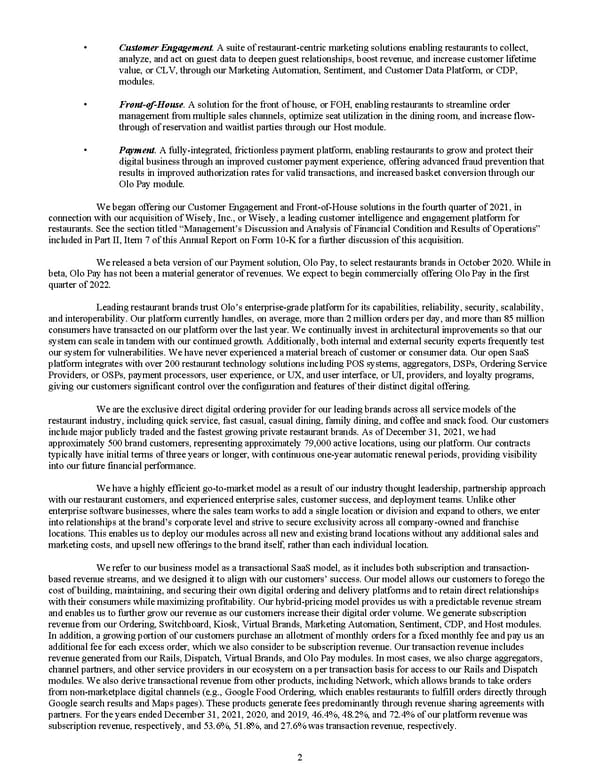• Customer Engagement . A suite of restaurant-centric marketing solutions enabling restaurants to collect, analyze, and act on guest data to deepen guest relationships, boost revenue, and increase customer lifetime value, or CLV, through our Marketing Automation, Sentiment, and Customer Data Platform, or CDP, modules. • Front-of-House . A solution for the front of house, or FOH, enabling restaurants to streamline order management from multiple sales channels, optimize seat utilization in the dining room, and increase flow- through of reservation and waitlist parties through our Host module. • Payment . A fully-integrated, frictionless payment platform, enabling restaurants to grow and protect their digital business through an improved customer payment experience, offering advanced fraud prevention that results in improved authorization rates for valid transactions, and increased basket conversion through our Olo Pay module. We began offering our Customer Engagement and Front-of-House s olutions in the fourth quarter of 2021, in connection with our acquisition of Wisely, Inc., or Wisely, a leading customer intelligence and engagement platform for restaurants. See the section titled “Management’s Discussion and Analysis of Financial Condition and Results of Operations” included in Part II, Item 7 of this Annual Report on Form 10-K for a further discussion of this acquisition. We released a beta version of our Payment solution , Olo Pay, to select restaurants brands in October 2020. While in beta, Olo Pay has not been a material generator of revenues. We expect to begin commercially offering Olo Pay in the first quarter of 2022. Leading restaurant brands trust Olo’s enterprise-grade platform for its capabilities, reliability, security, scalability, and interoperability. Our platform currently handles, on average, more than 2 million orders per day, and m ore than 85 million consumers have transacted on our platform over the last year. We continually invest in architectural improvements so that our system can scale in tandem with our continued growth. Additionally, both internal and external security experts frequently test our system for vulnerabilities. We have never experienced a material breach of customer or consumer data. Our open SaaS platform integrates with over 200 restaurant technology solutions including POS systems, aggregators, DSPs, Ordering Service Providers, or OSPs, payment processors, user experience, or UX, and user interface, or UI, providers, and loyalty programs, giving our customers significant control over the configuration and features of their distinct digital offering. We are the exclusive direct digital ordering provider for our leading brands across all service models of the restaurant industry, including quick service, fast casual, casual dining, family dining, and coffee and snack food. Our customers include major publicly traded and the fastest growing private restaurant brands. As of December 31, 2021, we had approximately 500 brand customers, representing approximately 79,000 active locations, using our platform. Our contracts typically have initial terms of three years or longer, with continuous one-year automatic renewal periods, providing visibility into our future financial performance. We have a highly efficient go-to-market model as a result of our industry thought leadership, partnership approach with our restaurant customers, and experienced enterprise sales, customer success, and deployment teams. Unlike other enterprise software businesses, where the sales team works to add a single location or division and expand to others, we enter into relationships at the brand’s corporate level and strive to secure exclusivity across all company-owned and franchise locations. This enables us to deploy our modules across all new and existing brand locations without any additional sales and marketing costs, and upsell new offerings to the brand itself, rather than each individual location. We refer to our business model as a transactional SaaS model, as it includes both subscription and transaction- based revenue streams, and we designed it to align with our customers’ success. Our model allows our customers to forego the cost of building, maintaining, and securing their own digital ordering and delivery platforms and to retain direct relationships with their consumers while maximizing profitability. Our hybrid-pricing model provides us with a predictable revenue stream and enables us to further grow our revenue as our customers increase their digital order volume. We generate subscription revenue from our Ordering, Switchboard, Kiosk, Virtual Brands, Marketing Automation, Sentiment, CDP, and Host modules . In addition, a growing portion of our customers purchase an allotment of monthly orders for a fixed monthly fee and pay us an additional fee for each excess order, which we also consider to be subscription revenue. Our transaction revenue includes revenue generated from our Rails , Dispatch, Virtual Brand s , and Olo Pay modules. In most cases, we also charge aggregators, channel partners, and other service providers in our ecosystem on a per transaction basis for access to our Rails and Dispatch modules. We also derive transactional revenue from other products, including Network, which allows brands to take orders from non-marketplace digital channels (e.g., Google Food Ordering, which enables restaurants to fulfill orders directly through Google search results and Maps pages). These products generate fees predominantly through revenue sharing agreements with partners. For the years ended December 31, 2021 , 2020 , and 2019 , 46.4% , 48.2% , and 72.4% of our platform revenue was subscription revenue, respectively, and 53.6% , 51.8% , and 27.6% was transaction revenue, respectively. 2
 2022 10K Page 8 Page 10
2022 10K Page 8 Page 10